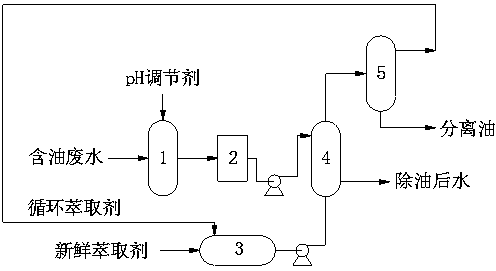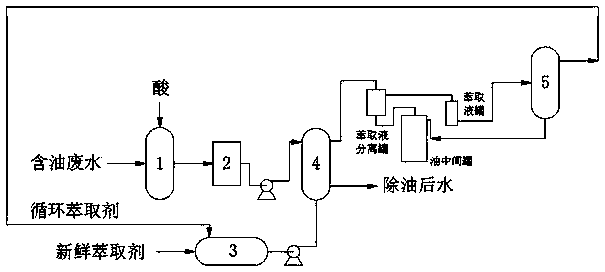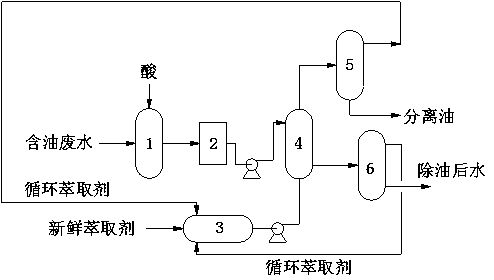Method for oil and phenol removal from wastewater in field of coal chemical industry
A technology for coal chemical industry and wastewater, which is applied in separation methods, extraction water/sewage treatment, grease/oily substances/suspton removal devices, etc., and can solve the requirements of single oil removal or phenol removal, no effect of soluble oil, and pretreatment Advanced problems, to achieve the effect of simplifying the process and time, improving the rate of oil and phenol removal, and less corrosive equipment
- Summary
- Abstract
- Description
- Claims
- Application Information
AI Technical Summary
Problems solved by technology
Method used
Image
Examples
Embodiment 1
[0048] In a coal chemical plant, the coal chemical wastewater treatment capacity is 57 tons / hour, of which the oil content is 1309 mg / L, and the soluble oil content in the oil content is 584 mg / L. figure 1 Process equipment flow chart for wastewater degreasing, the steps are as follows:
[0049] a. Wastewater pretreatment: firstly, the waste water enters the regulating tank, adds acid to make the pH at 4.4, and cools to 40°C through the cooler;
[0050] b. Extraction and degreasing: the pretreated waste water is pumped into the top of the extraction tower for countercurrent extraction with the extractant (cyclohexane) entering from the bottom. The volume ratio of the extractant to waste water is 1:10, and the plate The number is 13, the pressure at the top of the tower is 0.5 MPa, the temperature is 40°C, the pressure at the bottom of the tower is 1.1 MPa, and the temperature is 36°C. processing section;
[0051] c. Extractant recovery: After extraction, the extract phase en...
Embodiment 2
[0054] In a coal chemical plant, the coal chemical wastewater treatment capacity is 80 tons / hour, of which the oil content is 1530 mg / L, and the soluble oil content in the oil content is 570 mg / L. figure 2 Process equipment flow chart for wastewater degreasing, the steps are as follows:
[0055] aWastewater pretreatment: firstly, the wastewater enters the regulating tank, adds acid to make the pH at 3.5, and cools to 16°C through the cooler;
[0056] b. Extraction and degreasing: the pretreated waste water is pumped into the top of the extraction tower for countercurrent extraction with the extractant (cyclohexane) entering from the bottom. The volume ratio of the extractant to waste water is 1:5, and the trays The number is 1, the pressure at the top of the tower is 0.1MPa, the temperature is 15°C, the pressure at the bottom of the tower is 0.12MPa, the temperature is 16°C, the extraction phase is extracted from the top of the tower; the water phase after extraction and oil ...
Embodiment 3
[0060] In a coal chemical plant, the coal chemical wastewater treatment capacity is 53 tons / hour, of which the oil content is 1257 mg / L, and the soluble oil content in the oil content is 420 mg / L. image 3 Process equipment flow chart for wastewater degreasing, the steps are as follows:
[0061] a. Wastewater pretreatment: firstly, the waste water enters the regulating tank, adds acid to make the pH at 5.5, and cools to 30°C through the cooler;
[0062] b. Extraction and degreasing: pump the pretreated wastewater into the top of the extraction tower, and perform countercurrent extraction with the extractant (cyclohexane) entering from the bottom. The volume ratio of the extractant to wastewater is 1:8, and the trays The number is 12, the pressure at the top of the tower is 0.1MPa, the temperature is 28°C, the pressure at the bottom of the tower is 0.8MPa, the temperature is 30°C, the extraction phase is extracted from the top of the tower; the water phase after extraction and ...
PUM
| Property | Measurement | Unit |
|---|---|---|
| Oil removal rate | aaaaa | aaaaa |
| Removal rate | aaaaa | aaaaa |
Abstract
Description
Claims
Application Information
 Login to View More
Login to View More - R&D
- Intellectual Property
- Life Sciences
- Materials
- Tech Scout
- Unparalleled Data Quality
- Higher Quality Content
- 60% Fewer Hallucinations
Browse by: Latest US Patents, China's latest patents, Technical Efficacy Thesaurus, Application Domain, Technology Topic, Popular Technical Reports.
© 2025 PatSnap. All rights reserved.Legal|Privacy policy|Modern Slavery Act Transparency Statement|Sitemap|About US| Contact US: help@patsnap.com



